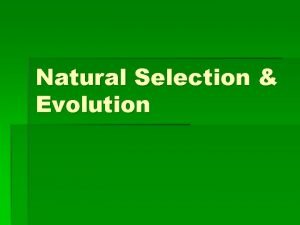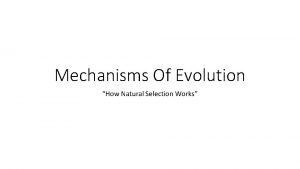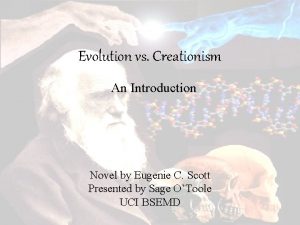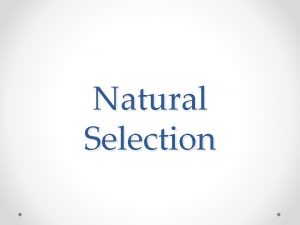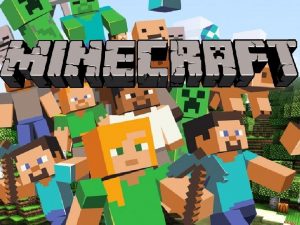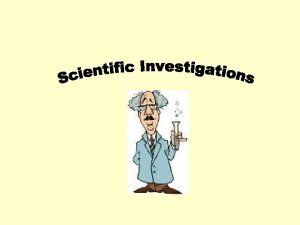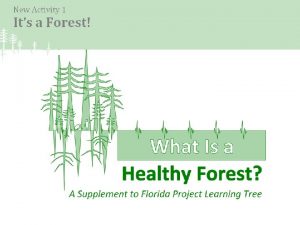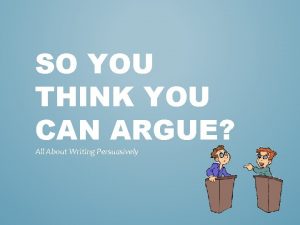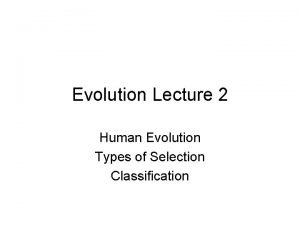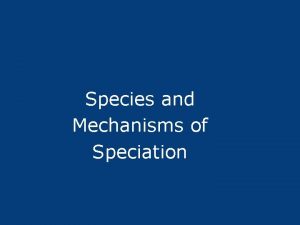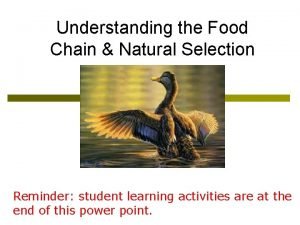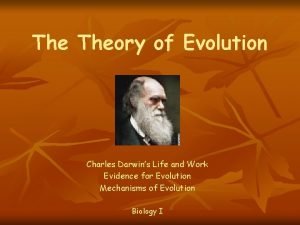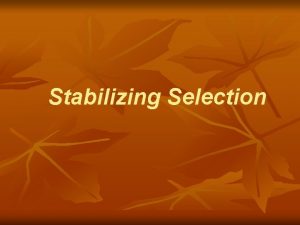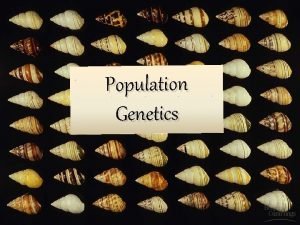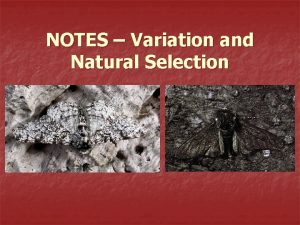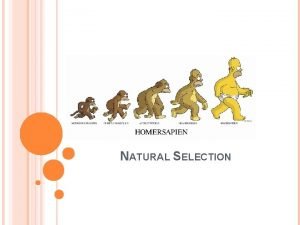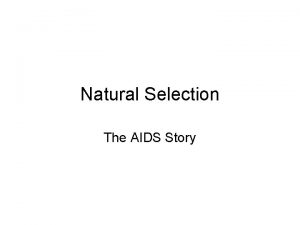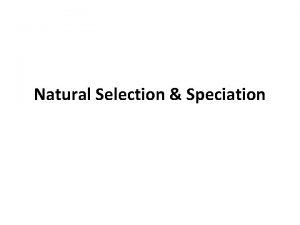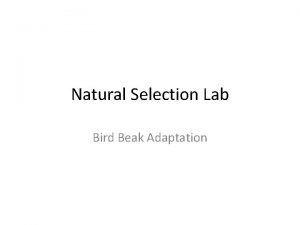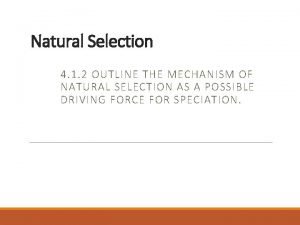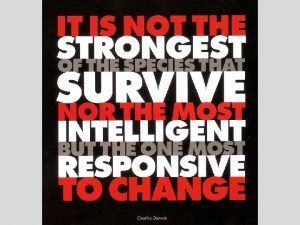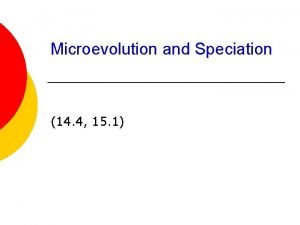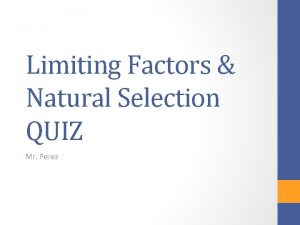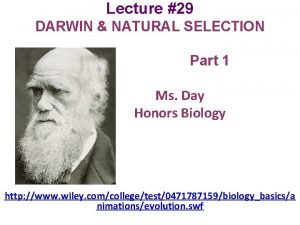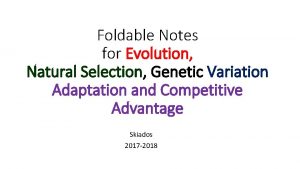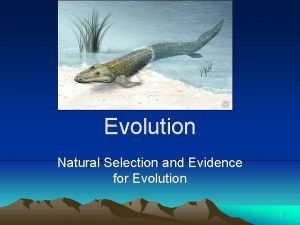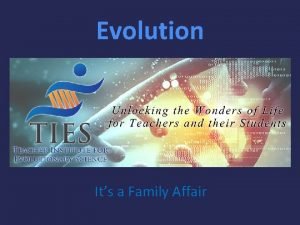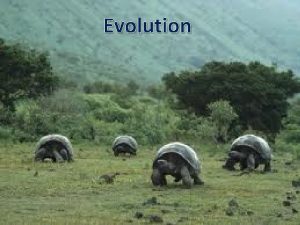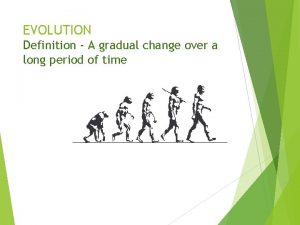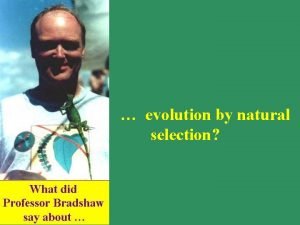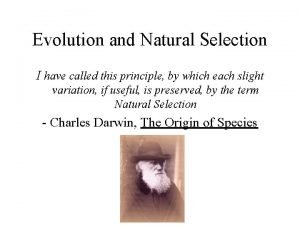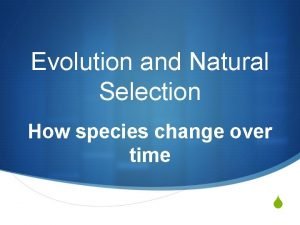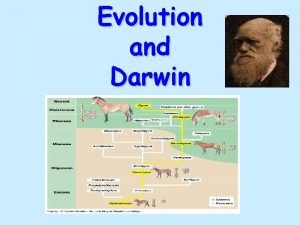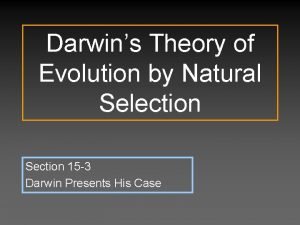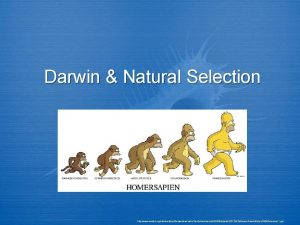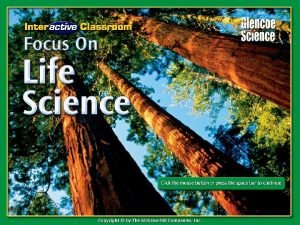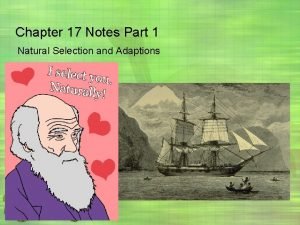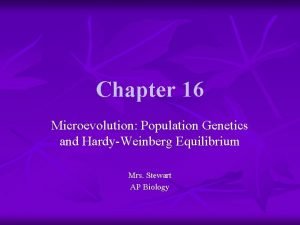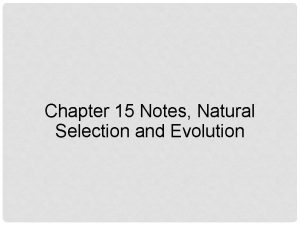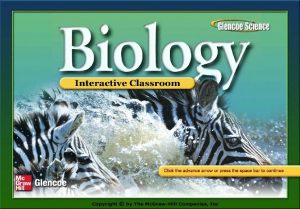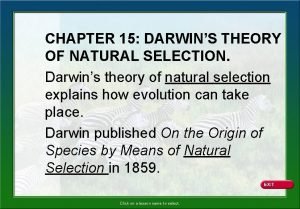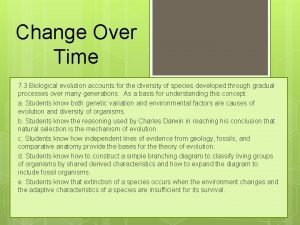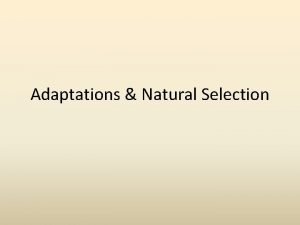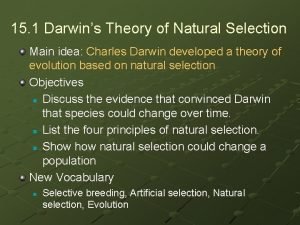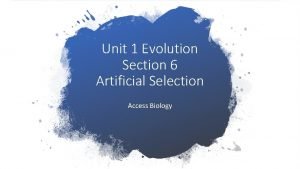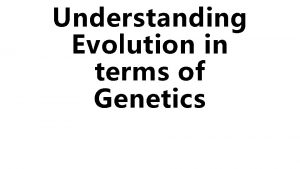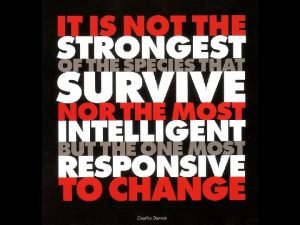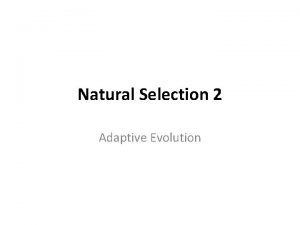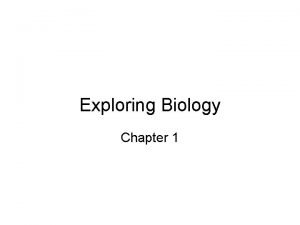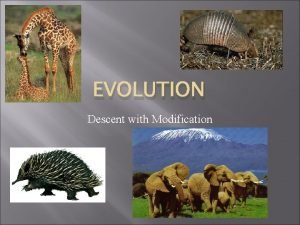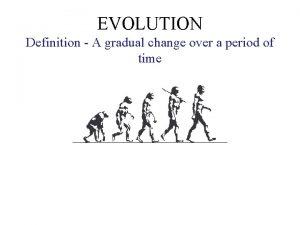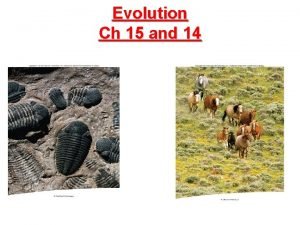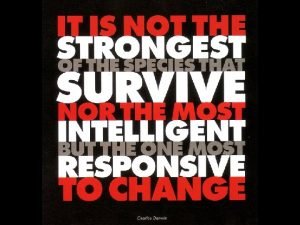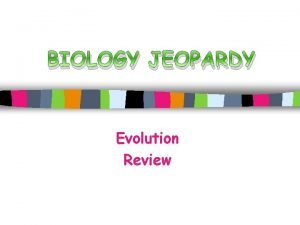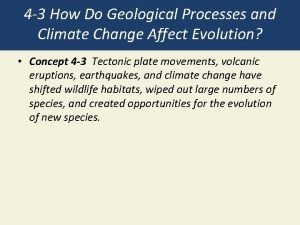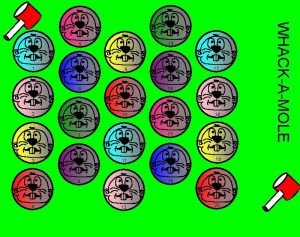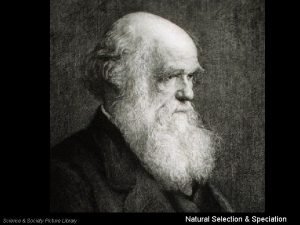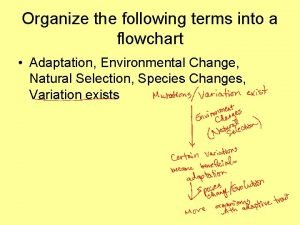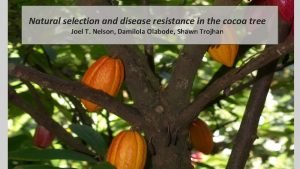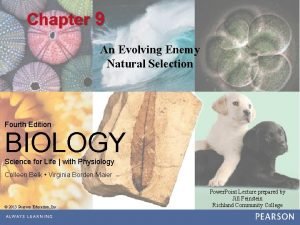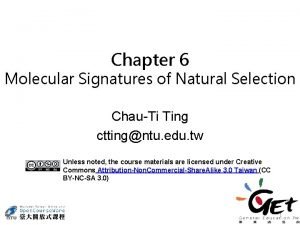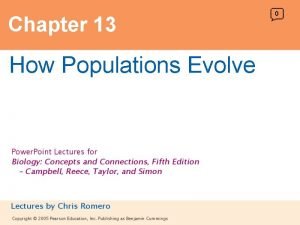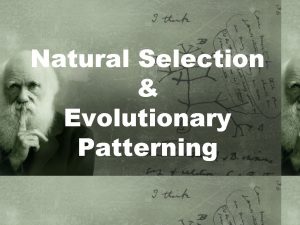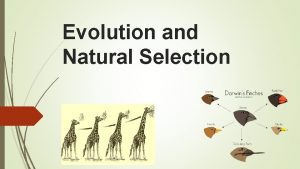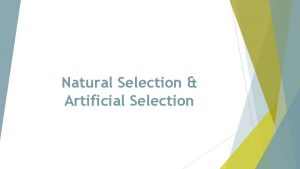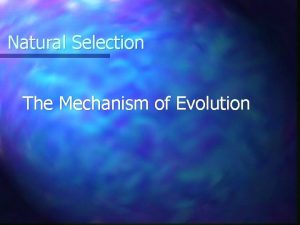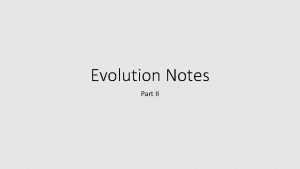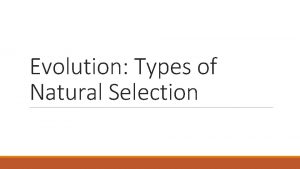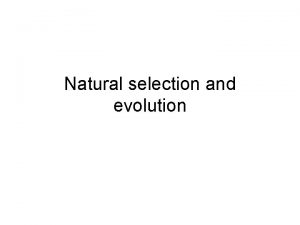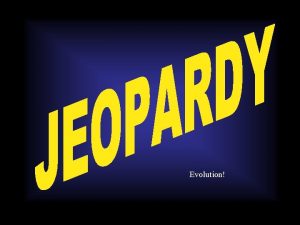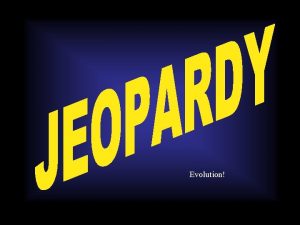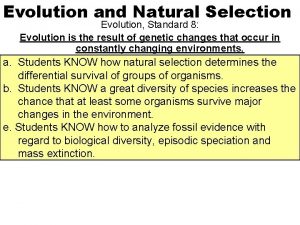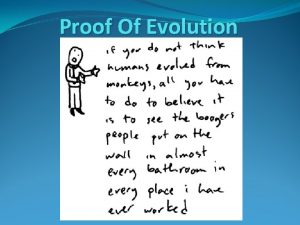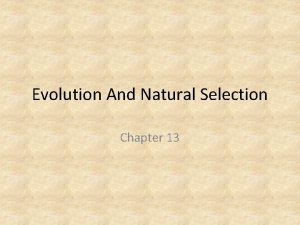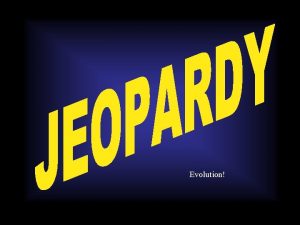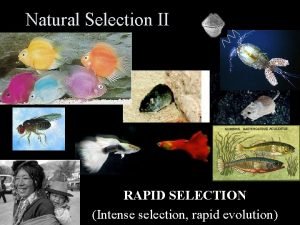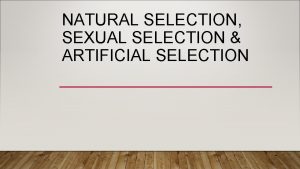Introducing Evolution Natural Selection What do you think

























































































- Slides: 89

Introducing Evolution & Natural Selection (What do you think you know? ) Australopithecus Homo erectus Homo sapiens

• Is Evolution is a theory on the origin of life? – No! – It is a theory explaining the origin of species • How old is the human species (Homo sapiens)? – ~195, 000 years old • What is the name of theory that teaches that humans evolved from monkeys? – No theory teaches that humans evolved from monkeys. Evolution indicates Humans and modern monkeys share a common ancestor

Evolution: Good Introduction Videos • Introduction to Evolution (4: 12) – https: //www. youtube. com/watch? v=Fpf. AZa. Vhx 3 k • Evolution Stated Clearly: (~8 min) – https: //www. youtube. com/watch? v=Gh. HOj. C 4 oxh 8 • Darwin’s Natural Selection Made Easy: (~6: 30 min) – https: //www. youtube. com/watch? v=FNz 9 a. HUTAT 8 • Charles Darwin (The man that changed the world) ~6 min – https: //www. youtube. com/watch? v=XKnqj 3 YFXU 8 • Bill Nye’s Evolution (Part 1) ~ 13 min – https: //www. youtube. com/watch? v=sv. HQ 4 BQY__o • Bill Nye’s Evolution (Part 2) ~ 8: 55 min (Good Intro) – https: //www. youtube. com/watch? v=QECq 6 M 3 n. Pew

Evolution: Charles Darwin’s Ideas commons. wikimedia. org/wiki/Image: DNA_double_helix_vertikal. PNG commons. wikimedia. org/wiki/Image: Charles_Darwin_1881. jpg

What you will learn………. • • How did the idea of “evolution” evolve? Early ideas of evolution………. Darwin’s voyage on the HMS Beagle Natural Selection (The mechanism for evolution) • Survival of the fittest and speciation

The Advent of Evolutionary Thought: Geologic Time/Fossils and Strata 1785 – James Hutton proposes that Earth is millions of years old In the 1800’s geologists like William Smith showed that different species existed in the past. William Smith, his geology map & some of his fossil specimens

Transmutation • Around 1800, scientists began to wonder whether species could change or transmute. • Lamarck thought that if an animal acquired a characteristic during its lifetime, it could pass it onto its offspring. Jean Baptiste de Lamarck • Hence giraffes got their long necks through generations of straining to reach high branches. commons. wikimedia. org/wiki/Image: Jean-baptiste_lamarck 2. jpg en. wikipedia. org/wiki/Image: Giraffe_standing. jpg

Darwin’s Voyage on the HMS Beagle • From 1831 -1836, a young naturalist named Charles Darwin sailed the world on the HMS Beagle. • He was amazed by the huge diversity of life he observed Voyage of the Beagle • He started to wonder how such diversity might have originated

On the islands of the Galapagos Darwin noticed tortoises and birds differed from island to island • Each island had its own type of tortoises and birds that were clearly different from other islands

Galapagos Tortoises

In 1859 - Darwin publishes On the Origin of Species describing a mechanism for the diversity of species known as Natural Selection

Survival of the Fittest & Natural Selection explains adaption • In his Origin of Species, Darwin proposed how one species might give rise to another. • There is a natural and inherent variation among a population of a species • Food and resources are limited and competition means that only the fittest would survive. • This would lead to the natural selection of the best adapted individuals and eventually the evolution of a new species. en. wikipedia. org/wiki/Image: Darwin%27 s_finches. jpeg Darwin in 1860








The Tree of Life • All living things share a common ancestor • We can draw a Tree of Life to show every species is related. • Evolution is the process by which one species gives rise to another and the Tree of Life grows en. wikipedia. org/wiki/Image: Phylogenetic_tree. svg

Evolution is not “just” a theory. ” It is a scientific theory that explains actual observations in the natural world Scientific theories are explanations that are based on lines of evidence, enable valid predictions, and have been tested in many ways. In contrast, the popular definition of theory— is a “guess” or “hunch. ” These conflicting definitions often cause unnecessary confusion about evolution.

Classwork/Homework • Read Section 1 (pgs 172 -179) in your text. • Complete section 2 of your study guide on chapter 15. • This week we’ll simulate natural selection with the Peppered Moth lab. • https: //www. youtube. com/watch? v=XKnqj 3 YFXU 8 – Evolution Full Length Video… beautiful natural footage – https: //www. youtube. com/watch? v=Ms. HEAn. PX 59 Y

Tomorrow…. The Peppered Moth Simulation Lab

Summary of Darwin’s Theory 1. Organisms differ; variation is inherited 2. Organisms produce more offspring than survive 3. Organisms compete for resources 4. Organisms with advantages survive to pass those advantages to their children 5. Species alive today are descended with modifications from common ancestors

Evidence for Evolution • • • Adaptations Fossils Anatomy & Physiology Embryology Biochemistry Geographic Distribution of Living Species

Adaptations: It starts in the Genes • The genetic make-up of an organism is known as its genotype. • An organism’s genotype and the environment in which it lives determines its total characteristic traits i. e. its phenotype. Genotype Phenotype commons. wikimedia. org/wiki/Image: DNA_double_helix_vertikal. PNG

Different phenotypes cause variation Individual organisms differ from each other.

Natural Selection results in favorable adaptation Selection of dark gene • Variations or mutations (different alleles) spread through a population by sexual reproduction. • If an allele exerts a harmful effect, it will reduce the ability of the individual to reproduce and the allele will probably be removed from the population. en. wikipedia. org/wiki/Image: Mutation_and_selection_diagram. svg • In contrast, variations with favorable effects are preferentially passed on.

A Real Example: Peppered Moth Haldane and the peppered moth • The Peppered Moth is an example of Natural Selection in action discovered by Haldane • During the Industrial Revolution the trees on which the moth rested became soot-covered. • This selected against the allele for pale color in the population (which were poorly camouflaged from predators) and selected for the dark color allele. http: //en. wikipedia. org/wiki/Image: Biston. betularia. 7200. jpg en. wikipedia. org/wiki/Image: Biston. betularia. f. carbonaria. 7209. jpg en. wikipedia. org/wiki/J. _B. _S. _Haldane

• More Evidence for Evolution • Fossils………. .

Evidence: The Fossil Record http: //en. wikipedia. org/wiki/Geologic_time_scale © World Health Org. en. wikipedia. org/wiki/Image: Eopraptor_sketch 5. png © NASA origins bacteria complex cells dinosaurs The fossil record shows a sequence from simple bacteria to more complicated organisms through time and provides the most compelling evidence for evolution. humans

Evidence: Transitional fossils • Many fossils show a clear transition from one species, or group, to another. • Archaeopteryx was found in Germany in 1861. It share many characteristics with both dinosaurs and birds. • It provides good evidence that birds arose from dinosaur ancestors Archaeopteryx en. wikipedia. org/wiki/Image: Archaeopteryx_lithographica_paris. JPG

Primate Fossils Australopithecus Homo erectus Homo sapien

• More Evidence for Evolution • Anatomy & Physiology………. .

Homologous Body Structures

Evidence: Comparative Anatomy • Similar comparisons can be made based on anatomical evidence. • The skeleton of humans and gorillas are very similar suggesting they shared a recent common ancestor, but very different from the more distantly related woodlouse… yet all have a common shared characteristic: bilateral symmetry Human and Gorilla Woodlouse en. wikipedia. org/wiki/Image: Primatenskelett-drawing. jpg

Primate Bone structure

Evidence: Vestigial Structures • As evolution progresses, some structures get side-lined as they are not longer of use. These are known as vestigial structures. • The coccyx is a much reduced version of an ancestral tail, which was formerly adapted to aid balance and climbing. • Another vestigial structure in humans is the appendix. The coccyx is a vestigial tail en. wikipedia. org/wiki/Image: Illu_vertebral_column. jpg

• More Evidence for Evolution • Embryology

13. Evidence of Evolution Similarities in Embryology – In their early stages of development, chickens, turtles and rats look similar, providing evidence that they shared a common ancestry.

Embryology

More Evidence: Biochemistry • The basic similarity of all living things suggests that they evolved from a single common ancestor. • As we have already seen, all living things pass on information from generation to generation using the DNA molecule. • All living things also use a molecule called ATP to carry energy around the organism. DNA for Information Transfer ATP for Energy Transfer en. wikipedia. org/wiki/Image: ATP-xtal-3 D-sticks. png

DNA as Evidence of Evolution • Studying DNA shows similarities between organisms • The more similar the DNA the more closely related species are • Example: The DNA of Gorillas and Humans are ~ 92% similar. The DNA of any two humans is ~99. 9% similar

Similar Genes HUMAN CCAAGGTCACGACTACTCCAATTGTCACAACTGTTCCAACCGTCACGACTGTTGAACGA CHIMPANZEE CCAAGGTCACGACTACTCCAATTGTCACAACTGTTCCAACCGTCA TGACTGTTGAACGA GORILLA CCAAGGTCACAACTACTCCAATTGTCACAACTGTTCCAACCGTCACGACTGTTGAACGA Genetic code of chimps and gorillas is very close to human code • Evolution suggests we would expect that DNA in closely related organisms to be more similar to one another than more distantly related organisms. • Comparison of the human genetic code with that of other organisms show that chimpanzees are nearly genetically identical (differ by less than 1. 2%) whereas the mouse differs by 15%.

Evidence: Geography Marsupials • Geographic spread of organisms also tells of their past evolution. • Marsupials occur in two populations today in the Americas and Australia. • This shows the group evolved before the continents drifted apart evolution. berkeley. edu/evosite/lines/IVCexperiments. shtml en. wikipedia. org/wiki/Image: Kangaroo_and_joey 03. jpg

Geographic Distribution

Evolution happens every day: Antibiotic resistance Staphylococcus • We are all familiar with the way that certain bacteria can become resistant to antibiotics • This is an example of natural selection in action. The antibiotic acts as an environmental pressure. It weeds out those bacteria with low resistance and only those with high resistance survive to reproduce. http: //en. wikipedia. org/wiki/Image: Antibiotic_resistance. svg en. wikipedia. org/wiki/Image: Staphylococcus_aureus%2 C_50%2 C 000 x%2 C_USDA%2 C_ARS%2 C_EMU. jpg

Evolution is a Scientific Theory – Just like Gravity & Relativity • Evolution is a well supported explanation for an observable set of facts Remember……. A theory in science is a well tested hypothesis, not just a guess!

• “I don’t understand it……. . ……… so God must have done it” • This is not a intelligent substitute for science • Science is about asking questions, proving and understanding……… Learn, explore & understand • Don’t be lazy…. Don’t take the easy way out

Animal Evolution Project • • • You will have three days in the upstairs computer lab to complete your research and work on your powerpoint or poster. Can work in teams of two (not three or four) You must identify an animal/organism and illustrate/show 5 transitional species and fossils that led to the evolution of that species. Identify when each transitional species lived and the era they lived in (Have a slide/picture of each individually) List the different fossil features of each species (different sizes, feet shape, teeth shape, etc…. ) Show the family tree of the species and the geographic location of each (where did they originate)


Horse Evolution Fossil Record

The Fossil Record

EOHIPPUS The first equid was Hyracotherium, a small forest animal of the early Eocene. It looked nothing at all like a horse (10 – 20” hight). It resembled a dog with an arched back, short neck, short snout, short legs, and long tail. It browsed on fruit and soft foliage and probably would have had mannerisms more like that of a deer (timid, flighty, etc. ). This famous little equid was once known as Eohippus or “Dawn Horse”.

MESOHIPPUS The species Mesohippus celer appears suddenly in the late Eocene, approximately 40 million years ago. This animal was slightly larger than Eohippus, standing 24” at the shoulder. It no longer looked like as much like a dog. The back was less arched, the legs and neck a bit longer, and the stout and face distinctively longer. It had a shallow, facial fossa, and a depression on the skull. Mesohippus had three toes on all its feet and was still pad-footed. The fourth front toe was reduced to a vestigial stub.

MIOHIPPUS Soon after Mesohippus celer and its very close relative Mesohippus westoni appeared, a similar animal called Miohippus assiniboiensis arose, approximately 36 million years ago. A typical Miohippus was distinctly larger and had a slightly larger skull than a typical Mesohippus. The facial fossa was deeper and more expanded. In addition, the ankle joint had changed subtly. Miohippus also began to show a variable crest on its upper cheek teeth. In later horse species, this crest became a characteristic feature.

MERYCHIPPUS Seventeen million years ago, Merychippus joined the equine line and was about 10 hands or 40” tall, the tallest yet. The muzzle became elongated, the jaw deeper, and the eyes moved farther back to accommodate the large teeth roots. The brain was notably larger, with a fissured neocortex and a larger cerebellum, making Merychippus smarter and more agile than earlier horses. Overall, this species was distinctly recognizable as a horse with a very “horsey” head.

PLIOHIPPUS About 15 million years ago in the middle Miocene epoch arose Pilohippus, a three-toed horse. Gradual loss of the side toes is seen in this species through three successive strata. Pliohippus was very similar to and, until recently, thought to be the direct ancestor of Equus, except for two significant differences. First, Pliohippus’ skull has deep facial fossa whereas Equus has no facial fossae at all. Second, Pliohippus’ teeth are strongly curved while Equus’ teeth are very straight. Though Pliohippus is obviously related to Equus, the former probably did not give rise to the latter.

EQUUS The genus of all modern equines, the first Equus was about 13. 2 hands tall, pony size, with a classic “horsey” body – rigid spine, long neck, legs, and nose, and fused leg bones with no rotation. The brain was a bit larger than in early Dinohippus. Like Dinohippus, Equus was (and still is) one-toed, with side ligaments that prevent twisting of the hoof. This species has high-crowned, straight, grazing teeth with strong crests lined with cement.

Origin of Horses • • The modern form of horse evolved from small dog like animals that first appeared 60 million years ago. Over time wild ancestors of the modern horse evolved for millions of years in north America. They then spread to other parts of the world by travelling southwards to south America by crossing land bridges that connected north America to Europe and Asia during the ice age. Horses vanished from both north and south America in a wave of extinction that occurred at the end of the Pleistocene epoch, about 15, 000 years ago. Horses nearly became extinct in the rest of the world as well, by about 7000 years ago the worlds only horses were confined to a small area in the still open grasslands steppes of Ukraine and central Asia.

Horse Family Tree

Mechanisms of Evolution • • Hardy-Weinberg Principle Genetic Drift Founder Effect Types of selection (stabilizing, directional, disruptive) • Micro vs. Macro Evolution • Patterns of Evolution(divergent & convergent evolution)

The Hardy-Weinberg Theorem Used to describe a non-evolving population - mathematically. In large populations – allele frequencies will remain constant if: – – No mutations occur Random mating occurs No natural selection occurs No migration occurs • Deviation from H-W equilibrium usually results in evolution. • Understanding a non-evolving population, helps us to understand how evolution occurs.

Assumptions of the Hardy. Weinberg Theorem • Large population size: small populations can have chance fluctuations in allele frequencies (e. g. , fire, storm).

• Founder Effect: a cause of genetic drift attributable to colonization by a limited number of individuals from a parent population

No migration: immigrants can change the frequency of an allele by bringing in new alleles to a population.

Genetic Drift Occurs when there is a change in relative frequency of alleles

• Gene Flow: genetic exchange due to the migration of fertile individuals or gametes between populations (reduces differences between populations)

No net mutations: if alleles change from one to another, this will change the frequency of those alleles.

Random mating: if certain traits are more desirable, then individuals with those traits will be selected and this will not allow for random mixing of alleles.

No natural selection: if some individuals survive and reproduce at a higher rate than others, then their offspring will carry those genes and the frequency will change for the next generation.

What did you just learn? 1. What five things must occur to maintain Hardy-Weinberg equilibrium? – Large population – No mutations – No migration – Random mating – No natural selection

2. What tends to happens if there is deviation from H-W equilibrium? Evolution 3. What is the founder effect? An increase in the frequency of an allelic variation in a small population separated from the main population 4. What do mutations cause? Variation in phenotypes 5. What is non-random mating? When there is a preference to mate with specific phenotypes

Types of Natural Selection • Directional • Stabilizing • Disruptive

Microevolution The occurrence of small-scale changes in allele frequencies in a population, over a few generations, also known as change at or below the species level. – Ex. Bacteria developing antibiotic resistance • Darwin’s finches

Galapagos Finches (An example of Microevolution & Adaptive Radiation)

Macroevolution • Change above the level of species • Changes resulting in speciation • Microevolution leads to Macroevolution

Macroevolution • Macroevolution: major patterns and changes among living organisms over long periods of time. • The evidence comes from 2 main sources: fossils and comparisons between living organisms.

Species change over time. New species arise and some disappear.


Types of Evolution: Divergent Evolution • Occurs when two or more biological characteristics have a common evolutionary origin but have diverged over evolutionary time.

Divergent Evolution: Causes Macroevolution: Species alive today come from species that lived in the past.

Types of Evolution • Convergent Evolution-the process whereby organisms not closely related, independently evolve similar traits as a result of having to adapt to similar environments or ecological niches.


All organisms on earth are united into a single tree of life by common descent.

What did you just learn? 6. What are three types of natural selection? – Directional – Stabilizing – Disruptive (also know as diversifying)

7. What is Microevolution? Small-scale changes in the occurrence of phenotypes in a population that result in change or adaptations at or below the species level 8. What is Macroevolution? Changes above the level of species that results in speciation and the major patterns/branches in the tree of life

9. What is an example of adaptive radiation? Galapagos Finches 10. What is divergent evolution? When species have a common ancestor but have traits that have diverged over time (starts with adaptive radiation) 11. What is convergent evolution? When organisms not closely related independently evolve similar traits due to living in similar environments

Evolution Re-cap 1. Individual organisms differ from each other. Why? 2. Organisms produce more offspring than can survive, and many that survive do not reproduce. 3. Members must compete for resources. 4. Each organism has advantages and disadvantages. 5. Individuals best suited to their environment survive and reproduce most successfully. They pass these traits on to their offspring. (What is this called? ) 6. Species change over time. (What type of evolution? ) New species arise and some disappear. 7. Species alive today come from species that lived in the past. (What type of evolution is this? ) 8. All organisms on earth are united into a single tree of life by common descent. (Macroevolution)
 Ramaniklal ambani
Ramaniklal ambani Types of natural selection in evolution
Types of natural selection in evolution Genetic drift v gene flow
Genetic drift v gene flow Natural selection vs evolution
Natural selection vs evolution Natural selection definition biology
Natural selection definition biology Similarities
Similarities Natural selection vs artificial selection
Natural selection vs artificial selection Difference between continuous and discontinuous variation
Difference between continuous and discontinuous variation What is artificial selection
What is artificial selection Natural selection vs artificial selection
Natural selection vs artificial selection If you think you can you can poem
If you think you can you can poem A little bird by aileen fisher
A little bird by aileen fisher Think family ni
Think family ni So you think you can argue
So you think you can argue Choose the correct answers a-c a person who is
Choose the correct answers a-c a person who is So you think you can argue
So you think you can argue Did you know minecraft
Did you know minecraft What comes to mind when you hear the word 'family'?
What comes to mind when you hear the word 'family'? You have more potential than you think
You have more potential than you think What do you think of when you hear the word science?
What do you think of when you hear the word science? What do you think of when you hear
What do you think of when you hear You can argue
You can argue Three types of natural selection
Three types of natural selection Balancing selection vs stabilizing selection
Balancing selection vs stabilizing selection K selection r selection
K selection r selection Clumped dispersion
Clumped dispersion Two way selection and multiway selection in c
Two way selection and multiway selection in c Two way selection and multiway selection in c
Two way selection and multiway selection in c Mass selection and pure line selection
Mass selection and pure line selection Sympatric speciation
Sympatric speciation P**n
P**n 4 principles of natural selection
4 principles of natural selection Stabilizing selection human birth weight
Stabilizing selection human birth weight Requirements for natural selection
Requirements for natural selection Types of natural selection
Types of natural selection Theory of natural selection
Theory of natural selection 4 conditions of natural selection
4 conditions of natural selection 3 types of natural selection
3 types of natural selection Bird beak adaptation lab
Bird beak adaptation lab Genetic drift
Genetic drift Homologous structures
Homologous structures Ted ed natural selection
Ted ed natural selection Macroevolution vs microevolution
Macroevolution vs microevolution Natural selection examples
Natural selection examples Lamarck’s theory of evolution.
Lamarck’s theory of evolution. Natural selection foldable
Natural selection foldable Three types of selection
Three types of selection Artificial selection
Artificial selection 4 principles of natural selection
4 principles of natural selection Analougous
Analougous Similar pictures
Similar pictures Three types of selection
Three types of selection Criteria for natural selection
Criteria for natural selection Natural selection simulation at phet answers
Natural selection simulation at phet answers Evolution x os
Evolution x os Basic principles of natural selection
Basic principles of natural selection Wuhsd
Wuhsd Natural selection menu
Natural selection menu Doc ff-1 pill test
Doc ff-1 pill test Natural selection requirements
Natural selection requirements Natural selection definition
Natural selection definition Basic principles of natural selection
Basic principles of natural selection Chapter 15 section 1 darwins theory of natural selection
Chapter 15 section 1 darwins theory of natural selection Natural selection
Natural selection Overproduction in natural selection
Overproduction in natural selection A habitat supplying the necessary factors for existence
A habitat supplying the necessary factors for existence 4 principles of natural selection
4 principles of natural selection Picture of natural selection
Picture of natural selection Convergent evolution
Convergent evolution Examples of unequal survival/reproductive success
Examples of unequal survival/reproductive success Directional selection example
Directional selection example Directional stabilizing and disruptive selection
Directional stabilizing and disruptive selection Natural selection examples
Natural selection examples Natural selection
Natural selection Natural selection
Natural selection Is this true
Is this true Natural selection
Natural selection Pseudocele
Pseudocele Criteria for natural selection
Criteria for natural selection Mechanisms of evolution graphic organizer
Mechanisms of evolution graphic organizer Steiner tunnel test classifications
Steiner tunnel test classifications Evolution jeopardy review game
Evolution jeopardy review game How do geological processes affect natural selection
How do geological processes affect natural selection Natural selection will ultimately make a species
Natural selection will ultimately make a species Natural selection picture
Natural selection picture Natural selection flow chart
Natural selection flow chart Natural selection
Natural selection Natural selection and drug resistance
Natural selection and drug resistance Natural selection
Natural selection Genetic pool
Genetic pool

